|
Related FAQs: Acanthurus, Acanthurus Tangs 2, Acanthurus Tangs
3, Acanthurus ID, Acanthurus Behavior, Acanthurus Compatibility, Acanthurus Selection, Acanthurus Systems, Acanthurus Feeding, Acanthurus Disease, Acanthurus Reproduction, Surgeons In General,
Tang ID, Selection, Tang Behavior, Compatibility, Systems, Feeding, Disease,
This Article Began as Part 1: Tangs of the Genus
Acanthurus
Related Articles: Tangs, Surgeons,
Doctorfishes, family Acanthuridae, species of Acanthurus:
A. leucosternon (Powder Blue),
A. sohal, A.
nigricans & A. japonicus, other tang genera: Ctenochaetus, Naso,
Paracanthurus, Prionurus, Zebrasoma, The Surgeon Family, Acanthuridae
/The Conscientious Marine Aquarist
The "Bad", Unknown and Just Too Dang Big Tangs,
Surgeons, Doctorfishes, of the Genus Acanthurus, Part 1 of 3
Bad Acanthurus and Unknowns:
Part 1, Part 2,
Part 3,
Good to Medium Acanthurus: Part 1,
Part
2
|

|
|
By Bob Fenner
|
Acanthurus olivaceus
|
Surgeonfishes: Tangs for Marine Aquariums
Diversity, Selection & Care
New eBook on Amazon: Available here
New Print Book on Create Space: Available
here
by Robert (Bob) Fenner |
 |
Bad Acanthurus Species:
What makes a tang species bad besides dying easily in
captivity; NOT dying easily... but helping your other livestock do so.
Honestly, some individuals of the fishes listed below will try to kill
all their tankmates. If you are set on trying one of the designated
"bad boys", do provide plenty of hiding spaces and tough,
tough, tough space-sharers (triggers, basses, morays, puffers)... and
even then keep your eye on them.
| Acanthurus. achilles Shaw 1803, Achilles
tang. Widely distributed from Hawaii westward through Micronesia
and Melanesia, an area called Oceania (also reported from
Mexico's Baja tip). Though the best specimens do hail from
U.S.s 50th state success with this species can only be had by
securing a healthy specimen, providing a large well-established
living space, with high, consistent specific gravity and oxygen
concentration. Shown below, a juvenile and adult Hawaii specimen
and one in the Cooks |
|
Acanthurus bariene Lesson 1830, the (Black)
Eye-Spot Surgeon, is collected from Australia and the Solomon
islands. Reportedly feeds largely on algal film on bare rocks.
Juveniles are found in shallow protected reefs, typically amongst
soft corals. This can be a quarrelsome fish, that ultimately
requires a large (hundreds of gallons) system. To one foot in
length. Here in Mabul, Malaysia.
|
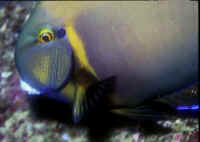
|
Bigger PIX:
The images in this table are linked to large (desktop size) copies.
Click on "framed" images to go to the larger size. |
|
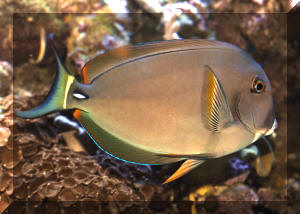
|
|
Acanthurus blochii Valenciennes 1835, the
Ringtail Surgeonfish. A larger (up to seventeen inches) schooling
species, often found shoaling over sandy areas. Found widespread
throughout the tropical Indo-Pacific. Note the white bar across
this species caudal peduncle. Shown, a juvenile and adults in
Hawai'i.
|
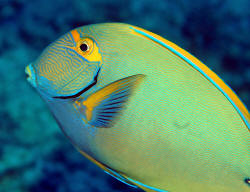 |
Bigger PIX:
The images in this table are
linked to large (desktop size) copies. Click on "framed"
images to go to the larger size. |
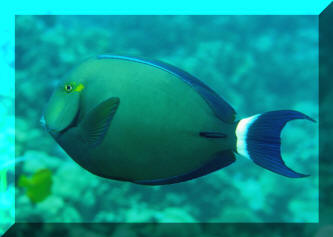 |
|
Acanthurus chirurgus Doctorfish. The only TWA tang
w/ faint body bars. To 14". Cozumel 2016.
|
%20MD.JPG) |
|
Acanthurus leucopareius (Jenkins 1903), the
Whiteband or Whitebar Surgeonfish, tends to be a picky feeder,
hard to train off its favored food, filamentous algae. To about
eight inches overall length. Pacific; Southern Japan to Noumea
over to Hawai'i. Hawai'i images of a juvenile,
sub-adult and adult.
|
Bigger PIX:
The images in this table are linked
to large (desktop size) copies. Click on "framed" images
to go to the larger size. |
|
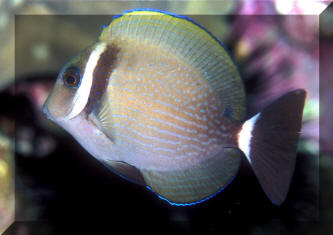
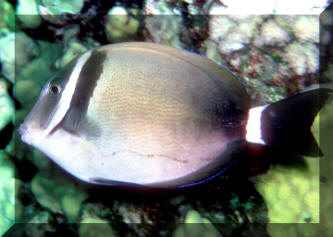
|
Bad Acanthurus and Unknowns:
Part 2,
Part 3,
Good to Medium Acanthurus: Part 1,
Part
2
Surgeonfishes: Tangs for Marine Aquariums
Diversity, Selection & Care
New eBook on Amazon: Available here
New Print Book on Create Space: Available
here
by Robert (Bob) Fenner |
 |
|
|

